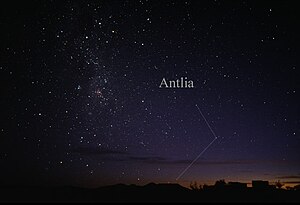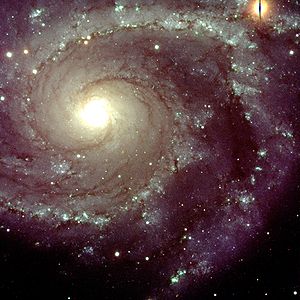Antlia
| Constellation | |
62nd) | |
| Main stars | 3 |
|---|---|
| Bayer/Flamsteed stars | 9 |
| Stars with planets | 2 |
| Stars brighter than 3.00m | 0 |
| Stars within 10.00 pc (32.62 ly) | 2 |
| Brightest star | α Ant (4.25m) |
| Messier objects | 0 |
| Meteor showers | None |
| Bordering constellations | Hydra Pyxis Vela Centaurus |
| Visible at latitudes between +45° and −90°. Best visible at 21:00 (9 p.m.) during the month of April. | |
Antlia (
Antlia is a faint constellation; its brightest star is Alpha Antliae, an orange giant that is a suspected variable star, ranging between apparent magnitudes 4.22 and 4.29. S Antliae is an eclipsing binary star system, changing in brightness as one star passes in front of the other. Sharing a common envelope, the stars are so close they will one day merge to form a single star. Two star systems with known exoplanets, HD 93083 and WASP-66, lie within Antlia, as do NGC 2997, a spiral galaxy, and the Antlia Dwarf Galaxy.
History

The French astronomer
Although visible to the Ancient Greeks, Antlia's stars were too faint to have been commonly recognised as a figurative object, or part of one, in ancient asterisms.[6] The stars that now comprise Antlia are in a zone of the sky associated with the asterism/old constellation Argo Navis, the ship, the Argo, of the Argonauts, in its latter centuries. This, due to its immense size, was split into hull, poop deck and sails by Lacaille in 1763.[11][12] Ridpath reports that due to their faintness, the stars of Antlia did not make up part of the classical depiction of Argo Navis.[13]
In non-Western astronomy
Chinese astronomers were able to view what is modern Antlia from their latitudes, and incorporated its stars into two different constellations. Several stars in the southern part of Antlia were a portion of "Dong'ou", which represented an area in southern China.[6] Furthermore, Epsilon, Eta, and Theta Antliae were incorporated into the celestial temple, which also contained stars from modern Pyxis.[6]
Characteristics
Covering 238.9 square degrees and hence 0.579% of the sky, Antlia ranks 62nd of the
Features

Stars
Lacaille gave nine stars Bayer designations, labelling them Alpha through to Theta, combining two stars next to each other as Zeta. Gould later added a tenth, Iota Antliae. Beta and Gamma Antliae (now HR 4339 and HD 90156) ended up in the neighbouring constellation Hydra once the constellation boundaries were delineated in 1930.[16] Within the constellation's borders, there are 42 stars brighter than or equal to apparent magnitude 6.5.[d][14] The constellation's two brightest stars—Alpha and Epsilon Antliae—shine with a reddish tinge.[18] Alpha is an orange giant of spectral type K4III that is a suspected variable star, ranging between apparent magnitudes 4.22 and 4.29.[19] It is located 320 ± 10 light-years away from Earth.[20] Estimated to be shining with around 480 to 555 times the luminosity of the Sun, it is most likely an ageing star that is brightening and on its way to becoming a Mira variable star, having converted all its core fuel into carbon.[21] Located 590 ± 30 light-years from Earth,[22] Epsilon Antliae is an evolved orange giant star of spectral type K3 IIIa, that has swollen to have a diameter about 69 times that of the Sun,[23] and a luminosity of around 1279 Suns.[24] It is slightly variable.[25] At the other end of Antlia, Iota Antliae is likewise an orange giant of spectral type K1 III.[26] It is 202 ± 2 light-years distant.[27]
Located near Alpha is
T Antliae is a yellow-white supergiant of spectral type F6Iab and Classical Cepheid variable ranging between magnitude 8.88 and 9.82 over 5.9 days.[38] U Antliae is a red C-type carbon star and is an irregular variable that ranges between magnitudes 5.27 and 6.04.[39] At 910 ± 50 light-years distant,[40] it is around 5819 times as luminous as the Sun.[24] BF Antliae is a Delta Scuti variable that varies by 0.01 of a magnitude.[41] HR 4049, also known as AG Antliae, is an unusual hot variable ageing star of spectral type B9.5Ib-II. It is undergoing intense loss of mass[42] and is a unique variable that does not belong to any class of known variable star, ranging between magnitudes 5.29 and 5.83 with a period of 429 days.[43] It is around 6000 light-years away from Earth.[44] UX Antliae is an R Coronae Borealis variable with a baseline apparent magnitude of around 11.85, with irregular dimmings down to below magnitude 18.0.[45] A luminous and remote star, it is a supergiant with a spectrum resembling that of a yellow-white F-type star but it has almost no hydrogen.[46]

Deep-sky objects

Antlia contains many faint galaxies,
The Antlia Cluster, also known as Abell S0636, is a cluster of galaxies located in the Hydra–Centaurus Supercluster. It is the third nearest to the Local Group after the Virgo Cluster and the Fornax Cluster.[56] The cluster's distance from earth is 40.5 to 40.9 Mpc (132.1 to 133.4 Mly)[57] Located in the southeastern corner of the constellation, it boasts the giant elliptical galaxies NGC 3268 and NGC 3258 as the main members of a southern and northern subgroup respectively, and contains around 234 galaxies in total.[52]
Antlia is home to the huge
Notes
- ^ The exception is Mensa, named for the Table Mountain. The other thirteen (alongside Antlia) are Caelum, Circinus, Fornax, Horologium, Microscopium, Norma, Octans, Pictor, Pyxis, Reticulum, Sculptor and Telescopium.[7]
- ^ Although parts of the constellation technically rise above the horizon to observers between the 49°N and 65°N, stars within a few degrees of the horizon are to all intents and purposes unobservable.[14]
- ^ Delporte had proposed standardising the constellation boundaries to the International Astronomical Union, who had agreed and gave him the lead role[15]
- ^ Objects of magnitude 6.5 are among the faintest visible to the unaided eye in suburban-rural transition night skies.[17]
References
Citations
- ISBN 978-0-521-44921-2.
- ^ a b c "Antlia, constellation boundary". The Constellations. Retrieved 14 February 2014.
- ^ "The 100 Nearest Star Systems". Research Consortium on Nearby Stars. 1 January 2012. Retrieved 2 May 2016.
- ^ Ridpath, Ian. "Lacaille's Southern Planisphere of 1756". Star Tales. Self-published. Retrieved 25 August 2015.
- ^ Lacaille, Nicolas Louis (1756). "Relation abrégée du Voyage fait par ordre du Roi au cap de Bonne-espérance". Mémoires de l'Académie Royale des Sciences (in French): 519–592 [589].
- ^ a b c d e Ridpath, Ian. "Antlia". Star Tales. Retrieved 3 December 2007.
- ^ a b Wagman 2003, pp. 5–6.
- .
- ^ Wagman 2003, p. 25.
- ^ Bibcode:1922PA.....30..469R.
- ISBN 978-1-55369-662-9.
- ISBN 978-0-486-20918-0.
- ISBN 978-0-7894-8988-3.
- ^ a b c d Ridpath, Ian. "Constellations: Andromeda–Indus". Star Tales. self-published. Retrieved 26 August 2015.
- ^ Ridpath, Ian. "Constellation boundaries: How the modern constellation outlines came to be". Star Tales. self-published. Retrieved 1 June 2016.
- ^ Wagman 2003, p. 29.
- ^ Bortle, John E. (February 2001). "The Bortle Dark-Sky Scale". Sky & Telescope. Archived from the original on 31 March 2014. Retrieved 26 August 2015.
- ISBN 978-0-7503-0654-6.
- ^ Watson, Christopher (18 January 2010). "Alpha Antliae". AAVSO Website. American Association of Variable Star Observers. Retrieved 25 July 2014.
- .
- ^ Kaler, James B. "Alpha Antliae". Stars. University of Illinois. Retrieved 25 July 2014.
- .
- S2CID 425754.
- ^ S2CID 118665352.
- S2CID 10505995.
- ^ "Iota Antliae". SIMBAD Astronomical Database. Centre de Données astronomiques de Strasbourg. Retrieved 29 July 2014.
- .
- .
- Bibcode:2000A&A...359..227H.
- S2CID 18759600.
- ^ S2CID 14878976.
- .
- ^ a b Ridpath 2017, pp. 76–78
- ^ Kaler, James B. (12 April 2013). "Theta Antliae". Stars. University of Illinois. Retrieved 25 March 2016.
- ^ Watson, Christopher (4 January 2010). "S Antliae". AAVSO Website. American Association of Variable Star Observers. Retrieved 22 May 2014.
- ^ S2CID 14661232.
- S2CID 118989357.
- ^ Watson, Christopher (4 January 2010). "T Antliae". AAVSO Website. American Association of Variable Star Observers. Retrieved 25 July 2014.
- ^ Otero, Sebastian (3 November 2011). "U Antliae". AAVSO Website. American Association of Variable Star Observers. Retrieved 25 July 2014.
- .
- S2CID 118900730. 132.
- doi:10.1086/185431.
- ^ VSX (4 January 2010). "AG Antliae". The International Variable Star Index. American Association of Variable Star Observers. Retrieved 15 June 2013.
- .
- ^ Otero, Sebastian (23 November 2012). "UX Ant". The International Variable Star Index. Retrieved 14 July 2014.
- Bibcode:1990Obs...110...90K.
- S2CID 119492030.
- S2CID 54713354.
- S2CID 13286883.
- S2CID 44050900.
- ^ "Mapping the nearby Universe". www.spacetelescope.org. Retrieved 25 September 2017.
- ^ Bibcode:2010MNSSA..69..107S.
- ^ Moore & Tirion 1997
- ^ Nemiroff, R.; Bonnell, J., eds. (23 April 1997). "Antlia: A New Galactic Neighbor". Astronomy Picture of the Day. NASA. Retrieved 9 April 2012.
- S2CID 118867213.
- S2CID 9042703.
- S2CID 763415.
- ^ "Primeval fireworks". NewScientist. Archived from the original on 26 December 2005. Retrieved 12 November 2022.
Sources
- Moore, Patrick; Tirion, Wil (1997), Cambridge Guide to Stars and Planets (2nd ed.), Cambridge University Press, ISBN 978-0-521-58582-8
- Ridpath, Ian (2017), Stars and Planets Guide, Princeton University Press, ISBN 978-0-691-17788-5
- Wagman, Morton (2003). Lost Stars: Lost, Missing and Troublesome Stars from the Catalogues of Johannes Bayer, Nicholas Louis de Lacaille, John Flamsteed, and Sundry Others. ISBN 978-0-939923-78-6.
External links
- The Deep Photographic Guide to the Constellations: Antlia
- The clickable Antlia
 Media related to Antlia (category) at Wikimedia Commons
Media related to Antlia (category) at Wikimedia Commons
